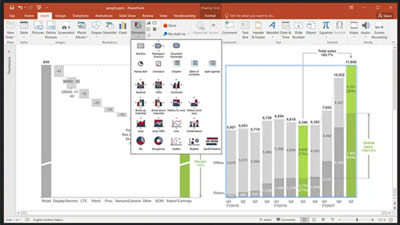Think Cell PowerPoint is the top PowerPoint software for consultants. While PowerPoint is the leading presentation software in the world, the standard version is not always the easiest or most efficient to use.
Manually creating visuals to present complex data in an easy-to-digest way is time consuming. Elements that represent common business metrics, such as compound annual growth rates, are not easily accessible. And once created, modifying these elements can be a pain-staking process.
Think-Cell PowerPoint aims to solve these problems. So, what is it, and should you use it?

What is Think Cell PowerPoint?
What is Think Cell PowerPoint? It’s an add-on that helps users create better-looking charts more efficiently.  Think Cell provides over forty types of charts, including some key charts not included in PowerPoint such as Gantt (or Timeline) and Mekko charts. Think Cell creates these charts from an internal Excel data sheet, but it can also pull from an existing spreadsheet. The software updates charts automatically as you change the data in the spreadsheet.
Think Cell provides over forty types of charts, including some key charts not included in PowerPoint such as Gantt (or Timeline) and Mekko charts. Think Cell creates these charts from an internal Excel data sheet, but it can also pull from an existing spreadsheet. The software updates charts automatically as you change the data in the spreadsheet.
[optin-monster slug="jztpviuk7dawcabwm1ud" followrules="true"]
Think Cell Software
Think Cell software has become the top PowerPoint software in consulting because it cuts work time down by 70%. How?
First, the software uses an algorithm to extract potential insights from collected data, and then displays that data in a clean, organized way. Think Cell PowerPoint also includes many automated features that make using the software more intuitive and allows you to skip steps that eat up a lot of time.
For example, instead of having to adjust one element at a time, Think Cell links multiple elements together and allows you to change them all at once. As you add or modify content in your slide, the layouts in Think Cell automatically adjust.
One of the advantages of Think Cell over other software for PowerPoint is that it only uses charts and shapes native to PowerPoint. This makes collaboration easier because team members who don’t use Think Cell can still access and modify the slides you create. In addition to this, if a software vendor goes out of business, you will still be able to access and change the charts you created. They will still be there as if you had created them with PowerPoint in the first place.
Using Think Cell in PowerPoint
Good news: Using Think Cell in PowerPoint should be a breeze for anyone who has experience with Excel or PowerPoint! Creating charts with Think Cell is not that different from creating them in the standard version of PowerPoint.
Think Cell simply works to fill in the gaps left in the original software by including several chart types and elements PowerPoint doesn’t have. The software also makes it easier to keep presentation structure consistent by linking slides, spreadsheets, and agendas so that when changes are made, they’re made across all three.
Once you install the software, Think Cell’s buttons will appear in the PowerPoint toolbar. When you insert the type of chart you want, an Excel spreadsheet automatically pops up. This is where you will enter your data to populate the chart. The process is similar to how you create charts in Excel.
Think Cell automatically places labels on charts to make editing simple. Click on the portion of the chart you want to edit, and options for chart theme, font, spacing, etc. will pop up. To add or remove labels, right click on the chart and it will give you the option to add or remove category labels.
Think Cell Excel
Think Cell software is also available for Excel. This software allows you to pull data straight from an existing Excel spreadsheet and create one of the forty types of charts available. The chart can instantly be created and linked to PowerPoint. As you modify or change the data in the spreadsheet, the chart can be updated with one click. If you have regular reports, you can automate these to cut down monthly work time.
Think Cell Excel also aims to solve the common problem of rounding numbers consistently in spreadsheets. The software has a feature that allows you to determine how you would like numbers to be rounded, then implements that throughout the worksheet even when complex calculations are involved. This feature can also be implemented across multiple worksheets.
Conclusion
Many consultants have found the Think Cell PowerPoint add-on to be a game-changer for their work process. Why spend hours dragging boxes around a PPT slide when you could use that time to better prepare for the presentation?
Think Cell is a paid add-on, but it does have a free trial available for corporate users. If you’re interested in learning more, visit the company’s website here.
And keep in mind – it’s more important to know how to structure a presentation and create a story than it is to know how to use Think Cell. Bring in our expert team to conduct a live presentation training for your company.
Additional Resources:
- Online Excel & PowerPoint Training
- 4 Guidelines To Excellent PowerPoint Storytelling
- How Consultants Use Excel
- Pyramid Principle Applied